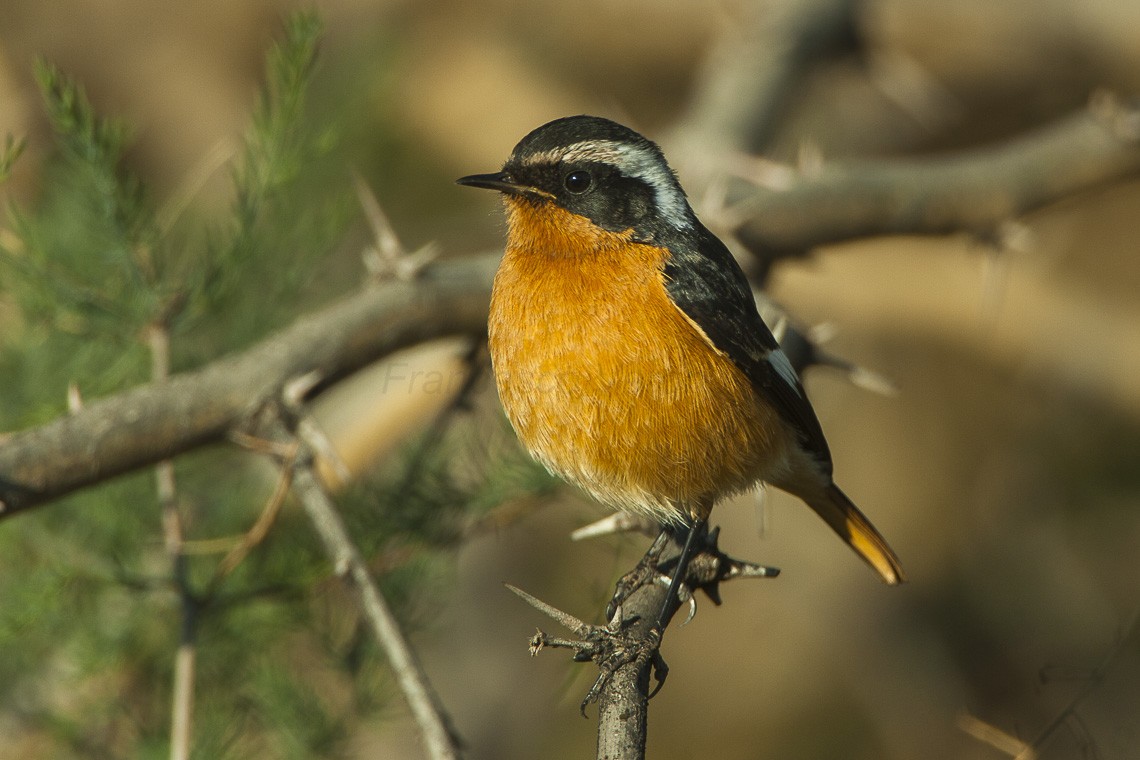Moussier's Redstart
A species of Typical Redstarts Scientific name : Phoenicurus moussieri Genus : Typical Redstarts
Moussier's Redstart, A species of Typical Redstarts
Botanical name: Phoenicurus moussieri
Genus: Typical Redstarts
Content
Description General Info
 Photo By Francesco Veronesi , used under CC-BY-SA-2.0 /Cropped and compressed from original
Photo By Francesco Veronesi , used under CC-BY-SA-2.0 /Cropped and compressed from original Description
Moussier's redstart (Phoenicurus moussieri) is a small passerine bird in the genus Phoenicurus (redstarts), formerly classed as a member of the thrush family (Turdidae), but is now classified as an Old World flycatcher (Muscicapidae). It is an endemic resident breeder in the Atlas Mountains of northwest Africa. Its habitat is open woodland in rocky areas from sea level up to 3000 m altitude in the mountains. It is the smallest redstart, only 12 cm long and 14–15 g weight. The male has a black head with a broad white stripe running above each eye and down the side of the neck. The upperparts are black other than a white wing patch, and the rich chestnut tail, from which it and other redstarts get their names (start is an old word for tail). The underparts are a rich orange-red. The female has a pale brown head and upperparts, and the underparts are a paler orange than the male, although generally redder than the underparts of the similar but larger female common redstart. It is named after Jean Moussier (1795–1850) who was an amateur naturalist and a surgeon in the French Army during the Napoleonic Wars. 
Size
12 cm
Nest Placement
Shrub
Feeding Habits
Moussier's Redstart primarily feeds on insects like ants, beetles, and grasshoppers, including larvae and vegetable matter. It forages by perching and pouncing from low vegetation, occasionally digging or aerially chasing insects. Unique for its preference for small ants and efficient hunting, performing repeated quick flights to catch prey.
Habitat
The moussier's Redstart typically inhabits open, rugged hilly regions and stony plateaux characterized by xerophytic steppe scrub and dry areas with sparse xerophytic bushes and trees. It is found in upland rocky meadows, open scrub woodlands, and the clearings and edges of forests in broader geographical regions including Mediterranean environments. The moussier's Redstart is also present in argan bush landscapes, cultivated valleys, and in winter, migrates to flatter, more arid areas with scrub and bushes near water sources and plains.
Dite type
Insectivorous
General Info
Feeding Habits
Bird food type
Behavior
The male's song is a mixture of rasping sounds and svee-svee notes. The call is a plaintive single note, wheet. It is primarily insectivorous, often feeding like a flycatcher, making aerial sallies after passing insects, but also picking and even digging insects out of the ground; more rarely, it will eat small berries. Its nest is built in a bush or on the ground and the clutch is typically 3-6 eggs. Although largely resident, some show limited migratory behaviour, particularly altitudinal migration by those breeding at high altitudes moving to lower levels in winter. Vagrants have reached north to Great Britain (Dinas Head, Pembrokeshire; April 1988), east to Greece, and south to Mauritania. 
Species Status
Not globally threatened.
Scientific Classification
Phylum
Chordates Class
Birds Order
Perching birds Family
Old world flycatchers Genus
Typical Redstarts Species
Moussier's Redstart